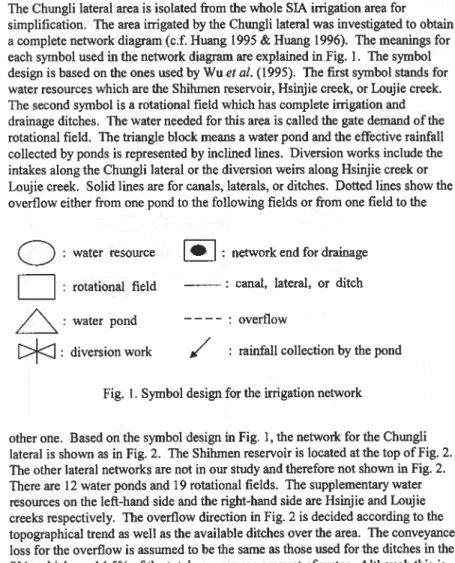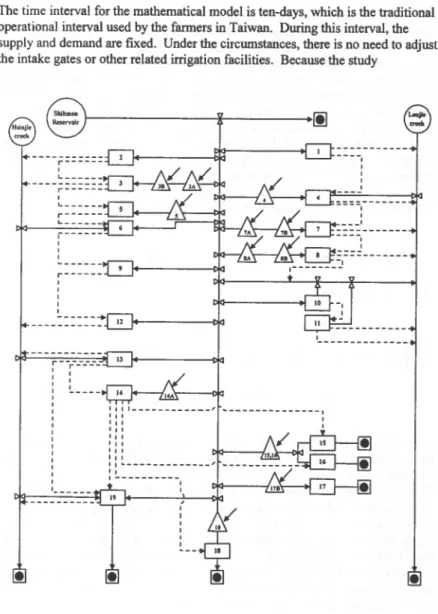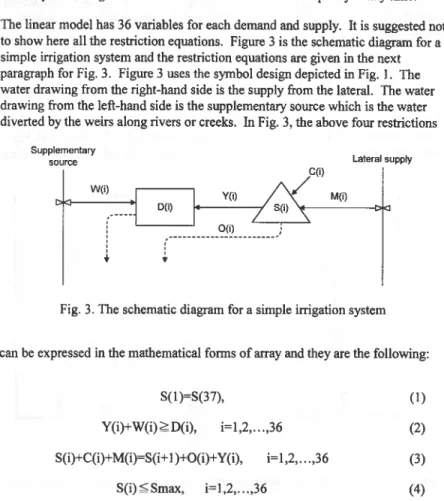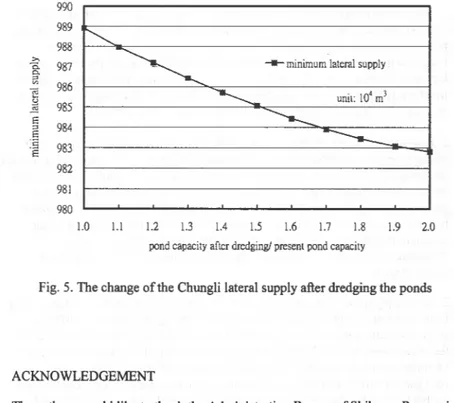Wen-Tsun Fangl
Mei-Jen Pengl
ABSTRACT
This study investigated the combined operation of the laterals and the ponds by applying the linear programming. The linear programming is able to give an optimal operation schedule so that the irrigation water requirement is reduced. As an important irrigation area with high density of ponds in Taiwan, the Chungli lateral and the neighborhood were thoroughly surveyed and the irrigation network was completed. Based on the water balance equations, the linear programming considered the spatial and temporal operation relation between the lateral, the ponds and the whole irrigation area. Due to limited water resources, the objective function of the linear programming is the minimum of the total requirement for the Chungli lateral. The combination in series or in parallel of ponds with the overflow either from one pond to the following fields or from one field to the other one was taken into account in order for an accurate numerical simulation. Besides from the ponds and the laterals, the supplementary water resources for irrigation include those from diversion weirs and effective rainfall.
The ways to improve the present irrigation system for better utilization of water resources were also proposed. As an estimation, the pond dredging can reduce the water requirement by the amount of about 1 x 104m3 for the original requirement 988.92 x 104m3 in the Chungli laterals.
INTRODUCTION
The demand of water resource is increasing at a very rapid pace, however the searching for the sources of available water is more difficult than before. At the
IAssociate Research Scientist, Water Resources Section, Agriculture Eng. Research Center, 196-1, Chung Yuan Rd., Chungli, Taiwan 320, ROC 2Assistant Technician, Water Resources Section, Agriculture Eng. Research Center, 196-1, Chung Yuan Rd., Chungli, Taiwan 320, ROC
same time, the cost for a new water-resources planning is incommensurable in some aspects. In Taiwan the construction of a water-resources project becomes the concern of engineers, biologists, as well as political scientists. Therefore, in stead of paying more attention in new water-resources projects, how to efficiently utilize existing water resources becomes the most important challenge in Taiwan. There are 17 irrigation associations in Taiwan which are responsible for the maintenance and construction of irrigation facilities as well as the arrangement of water for the farmland. Located at the one of the most important area for foodstuff production, the Shihmen Irrigation Association (SIA) operates a complete irrigation network, which is the combination of the Shihrnen reservoir, 1 leading canal (4,489m), 1 main canal (27,363m), 18 lateral canals (lOlkm), 43 sub-lateral canals (1 76km), ditches (1,700km), 460 water ponds and 156 diversion weirs. According to the original construction design of the Shihrnen reservoir, the reservoir can only supply about 48% of the total irrigation demand, while the other water resources such as water ponds, effective rainfall, and diversion weirs cover the rest. All the water resources are supposed to be allocated to the farmland through the effective utilization of the water ponds.
The SIA irrigation area is all cultivated as paddy fields. The fields which contain complete irrigation and drainage ditches are called rotational fields. The SIA posts irrigation plans for the whole area at the beginning of every year. The SIA management persons operate the facilities, such as intake gates, to supply the scheduled water allocation to the fields. The pond owners cooperate with the SIA to let the ponds either in series or in parallel serve as water buffers for adjustment. The farmers can draw irrigation water from sub-laterals or ditches according to the irrigation plan. Thus the above constitutes a very special feature of irrigation water allocation in Shihrnen. Because the simulation of all the irrigation facilities in combination needs tremendous numerical calculation, only the Chungli lateral area is thoroughly studied.
An efficient irrigation water allocation needs cooperation among irrigation facilities. The SIA (1978) studied the pond operation problems and the study area was limited to a pond and a rotational field. The SIA's report (1978) is therefore lack of application value. This study will consider actual situation and adopt linear programming model to find out the minimum of the lateral supply under restrictions. This thus gives the results which can be used by the SIA in routine operation.
IRRIGA nON NETWORK
The Chungli lateral area is isolated from the whole SIA irrigation area for
simplification. The area irrigated by the Chungli lateral was investigated to obtain
a complete network diagram (c.f. Huang 1995 & Huang 1996). The meanings for
each symbol used in the network diagram are explained in Fig. I. The symbol
design is based on the ones used by Wu et al. (1995). The first symbol stands for
water resources which are the Shihmen reservoir, Hsinjie creek, or Loujie creek. The second symbol is a rotational field which has complete irrigation and drainage ditches. The water needed for this area is called the gate demand of the
rotational field. The triangle block means a water pond and the effective rainfall
collected by ponds is represented by inclined lines. Diversion works include the
intakes along the Chungli lateral or the diversion weirs along Hsinjie creek or Loujie creek. Solid lines are for canals, laterals, or ditches. Dotted lines show the overflow either from one pond to the following fields or from one field to the
o :
water resourceD :
rotational field6. :
water pondc>t<J :
diversion work~
: network end for drainage- - : canal, lateral, or ditch - - - - : overflow
/ ' : rainfall collection by the pond
Fig. I. Symbol design for the irrigation network
other one. Based on the symbol design in Fig. I, the network for the Chungli
lateral is shown as in Fig. 2. The Shihmen reservoir is located at the top of Fig. 2.
The other lateral networks are not in our study and therefore not shown in Fig. 2. There are 12 water ponds and 19 rotational fields. The supplementary water resources on the left-hand side and the right-hand side are Hsinjie and Loujie creeks respectively. The overflow direction in Fig. 2 is decided according to the
topographical trend as well as the available ditches over the area. The conveyance
loss for the overflow is assumed to be the same as those used for the ditches in the SlA, which are 14.5% of the total conveyance amount of water. Although this is not a precise way to calculate conveyance loss, it is a conventional and convenient way to calculate the conveyance loss in Shihmen Reservoir Irrigation Area.
LINEAR PROGRAMMING
The time interval for the mathematical model is ten-days, which is the traditional operational interval used by the farmers in Taiwan. During this interval, the supply and demand are fixed. Under the circumstances, there is no need to adjust the intake gates or other related irrigation facilities. Because the study
r---~~---+~ r -I L. _ _ _ _ _ _ r---~--~--~~--~~ r---I I I r -I I I I I
---+
I I I 1 ____________ , ~ ______________ , I I I I I I I I I I I I I I I I I I I I I II~---, I I 1---. I , I I I I I IFig. 2. The schematic diagram of the Chungli lateral irrigation network
•
for each demand consists of 36 variables. To understand the only function of the water ponds, the seasonal change of the reservoir's storage is not taken into account. The objective function of the linear model is to minimize the supply amount of the Chungli lateral with the established effective capacity of water ponds. The restrictions for the linear model are the following:
A. The water ponds show no change in the storage from year to year; B. The gate demand for all rotational fields is satisfied;
C. The total input and yield for the water ponds are in balance;
D. The pond storage is less than the maximum effective capacity at any time. The linear model has 36 variables for each demand and supply. It is suggested not to show here all the restriction equations. Figure 3 is the schematic diagram for a simple irrigation system and the restriction equations are given in the next paragraph for Fig. 3. Figure 3 uses the symbol design depicted in Fig. I. The water drawing from the right-hand side is the supply from the lateral. The water drawing from the left-hand side is the supplementary source which is the water diverted by the weirs along rivers or creeks. In Fig. 3, the above four restrictions
Supplementary source W(i) , , , , , ,
+
Lateral supply M(i) ,•
Fig. 3. The schematic diagram for a simple irrigation system
can be expressed in the mathematical fonns of array and they are the following:
S(I)=S(37),
Y(i)+W(i) ~ D(i), i=I,2, ... ,36 S(i)+C(i)+M(i)=S(i+ 1 )+O(i)+ Y(i), i=I,2, ... ,36
S(i)~Smax, i=1,2, ... ,36
(I)
(2) (3) (4)
where the index of the array indicates the i-th ten-<iays, SCi) is the storage of the pond, Y(i) is the yield of the pond, Wei) is the water amount diverted by the weir, D(i) is the gate demand, C(i) is the pond collection from effective rainfall, M(i) is the supply of the lateral, O(i) is the overflow of the pond, and Smax is the maximum effective capacity of the pond. The conveyance loss for the overflow of the ponds, the flow from the weirs to the ponds or to the rotational fields is all assumed to be the same as those used for the ditches inside the fields in SIA, which is 14.5% of the total conveyance amount of water. The objective function is the following:
Minimize [M(I)+M(2)+ ... +M(36»), (5) i.e., the total ten-days supply of the lateral is minimum. The whole mathematical model for the Chungli lateral can be constructed by following the same way in Eqs. (1) to (5).
RESULTS
The linear programming gives optimal schedule in the study area and the results oftotal demand and supply over a year are shown in Fig. 4. The abscissa in Fig. 4 is the time change in unit of ten-days and the ordinate is the total amount for water
1 2 0 , - - - . . ,
lOO~---~---w~---H+---1-~
...-totallatenlisupply
.... UlIalpondyl<id
...- r1Jnfall CO)lcclton by ponds
___ 1OIa1 aate demand
... LOtII supply from weirs
""'-10111.1 pond SloraiC Cnit 10 m"
~~----~~---ff_4r~--~~~---;
I 2 3 4 5 6 7 8 9 10 11 12 13 14 15 16 17 18 19 2Il 21 22 23 24 15 115 2J 28 29 30 31 32 33 34 35 36
No. of len·days
demands and supply. According to the irrigation plan of 1993 scheduled by SIA, the gate demand for the Chungli lateral for the year is 1,108.13 x 104m3, the
amount diverted by the weirs is 90 x 104m3, and the pond rainfall collection is 36
x 104m3. The results from the linear programming in Fig. 4 give that the minimum total supply of the Chungli lateral is 988.92 x 104m3• These indicate that the whole irrigation system of the Chungli lateral carries water amount of about 119.31 x 104m3 for a year from the supplementary resources of diversion
weirs and water ponds according to Restriction A. In the meantime, there is about 6.69 x 104m3 of water being lost during the conveyance either over the ditches, the
sub-laterals, or the overflow.
DISCUSSION
I. It is obviously shown that there are two peaks for water requirement in Fig. 4. The two peaks come at the time for ponding and plowing. The field ponding and plowing irrigation last for about 30 days. This can be understood from the irrigation plan of the SIA because the ponding and plowing are the time when the farm needs water most. The gate demand and the lateral supply have the similar trend but with about 5 X 104m3 of difference. The water from pond yield, pond
rainfall collection and the diversion weirs accounts for the difference.
2. Essentially the gate demand of the rotational fields is supplied by the lateral through the water ponds, however the original design in the Chungli lateral system has been changed because of the effect of urbanization in Chungli. According to our field investigation, the urbanization in Chungli forced a number of water ponds to be abandoned or filled with soil (The abandoned ponds may be still in the SIA's pond list.). As a result, there are 9 out of 19 rotational fields being irrigated directly from the Chungli without the adjustment by the ponds. Therefore, the function of ponds for the Chungli lateral may be reduced to a certain degree.
3. The supply from Chungli lateral has two peaks as discussed in the above. This is not an ideal way for operation management although the results satisfy the linear programming model. In the model the Chungli lateral area is isolated from the other lateral area for simplification. However, the main water resource, i.e., Shihmen reservoir, supplies water requirement for 18 laterals at the same time. An ideal operation management is to smooth out the peaks of water requirement so that the combination of 18 laterals will not ask Shihmen reservoir for peak water demand which may not be satisfied during a draught period. On the other hand, smoothing the peak demand will increase the conveyance loss during water transporting. The total lateral supply will be accordingly higher than the present results and will not be able to reach the objective function ofEq. (5).
4. In addition to the efficient pond operation, the minimizing oflateral supply can be achieved by dredging the ponds. This can increase pond's effective capacity. A pond with large effective capacity can store and yield more during drought. With the built mathematical model, the linear programming gives the Chungli lateral supply for the changing of pond's maximum effective capacity. The result is depicted in Fig. 5 and it shows that the Chungli lateral supply can be reduced by
the amount of 1 X I Q4m3 for the original requirement 988.92 X 1 Q4m3. This is at
best a rough estimation because the increasing of pond capacity adds difficulties
in transporting water in or out of ponds. On the other hand, when pond dredging
takes the financial factors into account, the final decision may be on the negative side. As described in the results, there is a notable amount of water being lost during the conveyance. The loss percentage of 14.5% can be reduced if the ditches and sub-laterals have entire lining and complete maintenance.
990 989 988 » 0. 0. 987 :;l 986 ~ 3 985 .!S
s
984'"
s
:§ 983s
~
~
... minimum lateral supply---
unit: 10 4 m3---
---982 981 980 1.0 1.1 1.2 1.3 1.4 1.5 1.6 1.7 1.8 1.9 2.0
pond capacity after dredging! present pond capacity
Fig. 5. The change of the Chungli lateral supply after dredging the ponds
ACKNOWLEDGEMENT
The authors would like to thank the Administration Bureau of Shihmen Reservoir and the Shihmen Irrigation Association for kind assistance in data collection.
REFERENCES
Huang, C.-P. 1995, Study on the Most Rational Irri~ation Requirement over Shihmen Reservoir Irri~ationArea (J), Report: AERC-95-RR-07, Agricultural Engineering Research Center, Chungli
Huang, c.-P. 1996, Study on the Most Rational Irri'lation Requirement over Shihmen Reservoir Irri~ation Area (J]I, Report: AERC-96-RR-ll, Agricultural Engineering Research Center, Chungli
Shihmen Irrigation Association 1978, Plannin~ on Farm Pond Improved in Shihmen Canal Irri~ated Area, Report: 77-B31-E-728, Taoyuan
Wu, T.-R.; Chien, C.-B. & Huang, C.-P. 1995, "Study on the Model for Dividing Irrigation Water of Reservoir and Pond Irrigation System", Proceeding of the Conference of Chinese Society of Agriculture Engineering in 1995, Taipei




